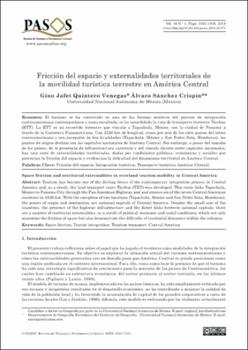Fricción del espacio y externalidades territoriales de la movilidad turística terrestre en América Central
Date
2018Abstract
El turismo se ha convertido en una de las fuerzas motrices del proceso de integración
centroamericana contemporánea y, como resultado, se ha consolidado la ruta de transporte terrestre Ticabus
(RTT). La RTT es un recorrido terrestre que vincula a Tapachula, México, con la ciudad de Panamá a
través de la Carretera Panamericana. Con 2526 km de longitud, cruza por seis de los siete países del istmo
centroamericano y con excepción de dos localidades (Tapachula, México y San Pedro Sula, Honduras), los
puntos de origen‑destino
son las capitales nacionales de América Central. Sin embargo, a pesar del tamaño
de los países, de la presencia de infraestructura carretera y del vínculo directo entre capitales nacionales,
hay una serie de externalidades territoriales, dadas por condiciones políticas, económicas y sociales que
potencian la fricción del espacio y evidencian la dificultad del dinamismo territorial en América Central. Tourism has become one of the driving forces of the contemporary integration process in Central
America and, as a result, the land transport route Ticabus (TRT) was developed. This route links Tapachula,
Mexico to Panama City through the Pan American Highway and and crosses six of the seven Central American
countries in 2526 km. With the exception of two locations (Tapachula, Mexico and San Pedro Sula, Honduras),
the points of origin and destination are national capitals of Central America. Despite the small size of the
countries, the presence of the highway infrastructure and the direct links between national capitals, there
are a number of territorial externalities, as a result of political, economic and social conditions, which not only
maximize the friction of space but also demonstrate the difficulty of territorial dynamics within the isthmus.





